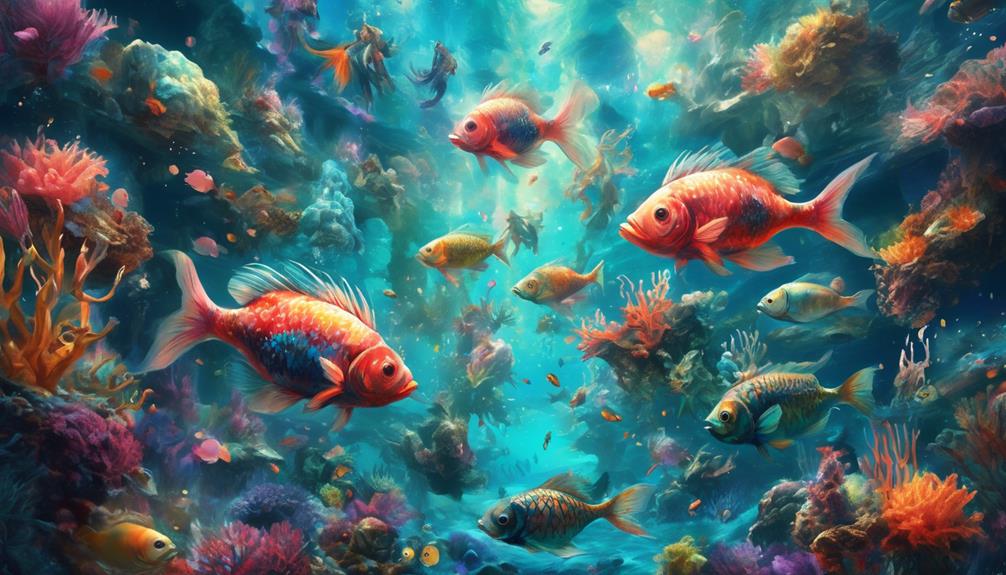Ancient mythological inspirations, historical evolution of mermaid parades, cultural significance of aquatic celebrations—these are just a few aspects that contribute to the rich tapestry of aquatic parade festivities.
The allure of these events stretches back through the annals of time, captivating the imagination and weaving a narrative that transcends generations. From the enigmatic lore of sea creatures to the vibrant modern-day traditions, there lies a fascinating journey waiting to be unraveled, shedding light on the origins and global influence of these captivating aquatic spectacles.
Key Takeaways
- Water has significant symbolism in ancient cultures, representing life, purity, and renewal.
- Mermaid parades have a historical evolution rooted in mythical origins and folklore, capturing the imagination of people for centuries.
- Aquatic celebrations hold ritual significance, symbolizing the importance of water as a life-giving force and fostering community bonding.
- The modern Mermaid Parade celebrates art, culture, and community, fostering inclusivity and honoring marine folklore.
Ancient Mythological Inspirations
The aquatic parade festivities find their origins in ancient mythological inspirations that have influenced various cultures and civilizations throughout history. Mythological interpretations have played a significant role in shaping the symbolic representations of these aquatic parades.
In many ancient cultures, water was seen as a symbol of life, purity, and renewal. The mythological stories often portrayed deities and mythical beings associated with water, such as Poseidon in Greek mythology or Varuna in Hindu mythology. These stories influenced the way people interacted with water, leading to the development of rituals and celebrations centered around it.
The symbolic representations of water in ancient myths have transcended time and continue to influence modern aquatic parade festivities. Water is often viewed as a boundary between the earthly realm and the divine, and participating in aquatic parades is seen as a way to connect with the spiritual world. The use of water in these parades symbolizes a cleansing of the past and a welcoming of new beginnings.
Understanding the mythological origins and symbolic representations provides a deeper appreciation for the cultural and spiritual significance of aquatic parade festivities.
Historical Evolution of Mermaid Parades
Evolution of mermaid parades unfolds as a captivating journey through the annals of cultural celebration and artistic expression. The historical evolution of mermaid parades can be traced back to their mythical origins, where these enchanting sea creatures have captured the imagination of people for centuries. The concept of mermaids, half-human and half-fish beings, has been a part of folklore and mythology across various cultures, from the siren-like creatures of Greek mythology to the ningyo of Japanese folklore. These mythical origins laid the foundation for the artistic expression that would later manifest in the form of mermaid parades.
Over time, mermaid parades have evolved into elaborate events that celebrate the allure and mystery of the sea. The parades often feature vibrant costumes, aquatic-themed floats, and mesmerizing performances that showcase the creativity and artistry of the participants.
From their early beginnings rooted in maritime folklore to becoming iconic fixtures in coastal communities and beyond, mermaid parades have carved out a unique space where mythical origins and artistic expression intersect, captivating audiences with their enchanting allure.
Cultural Significance of Aquatic Celebrations
Unveiling the cultural significance of aquatic celebrations reveals a deep-rooted connection to the mythical origins and artistic expression that have historically driven these festivities. Aquatic celebrations hold ritual significance, often harkening back to ancient folklore and mythologies surrounding water deities and creatures. These rituals are deeply ingrained in the traditions of many cultures, symbolizing the importance of water as a life-giving force and embodying the spiritual connection between communities and bodies of water.
The act of parading and performing alongside or in water is a symbolic representation of respect, gratitude, and reverence for these natural elements.
Furthermore, aquatic celebrations serve as a means of community bonding. These events bring people together, fostering a sense of unity and shared cultural identity. They offer a space for individuals to connect, celebrate, and partake in collective experiences, strengthening social ties and promoting a sense of belonging.
Whether through traditional ceremonies or modern-day festivities, aquatic celebrations continue to play a vital role in preserving cultural heritage and promoting solidarity within communities across the globe.
Modern-Day Mermaid Parade Traditions
With its roots in the whimsical and imaginative, modern-day Mermaid Parade traditions have evolved into a vibrant and eclectic celebration of art, culture, and community. The parade, inspired by marine folklore and mythical sea creatures, has become a platform for self-expression and creativity.
One of the most remarkable aspects of the modern Mermaid Parade is the spectacular costumes. Participants don a wide array of elaborate and colorful outfits, ranging from shimmering mermaid tails to intricate aquatic-themed ensembles. These costumes not only pay homage to the mystical beings of the sea but also showcase the artistic talents and craftsmanship of the parade's participants.
Beyond the visual spectacle, the parade embodies a sense of inclusivity and belonging. People from diverse backgrounds come together to revel in this imaginative display, fostering a strong sense of community and camaraderie.
Through its modern-day traditions, the Mermaid Parade continues to serve as a living, breathing canvas where individuals can express themselves, celebrate their connection to the sea, and honor the rich tapestry of marine folklore.
Global Influence and Adaptations
The influence of the Mermaid Parade has spread globally, inspiring diverse adaptations in celebrations and events around the world. This cultural fusion has led to the emergence of unique aquatic parades in various countries, each incorporating elements of local traditions and artistic expressions.
In Japan, for example, the 'Matsuri' festivals often feature captivating aquatic parades with intricately designed floats and traditional performances, reflecting the country's rich cultural heritage.
Similarly, in Brazil, the influence of the Mermaid Parade can be seen in the vibrant and lively 'carnaval' celebrations, where samba dancers and colorful floats create a spectacle that mirrors the spirit of aquatic festivities.
In Spain, events like the 'Fiesta de la Virgen del Carmen' showcase a fusion of maritime traditions with religious ceremonies, resulting in colorful processions and nautical-themed decorations.
These global adaptations of aquatic parade festivities not only highlight the universal appeal of such events but also demonstrate the power of cultural exchange and artistic interpretation in shaping diverse and enchanting celebrations worldwide.
Frequently Asked Questions
What Are the Most Popular Destinations for Modern-Day Mermaid Parades?
The most popular destinations for modern-day mermaid parades are Coney Island in New York, Asbury Park in New Jersey, and Virginia Beach in Virginia. These locations are top attractions for enthusiasts of parade traditions.
Are There Any Specific Rituals or Ceremonies Associated With Aquatic Parade Festivities?
Aquatic parade festivities often incorporate traditional rituals and ceremonial celebrations. These can include symbolic water blessings, costumed processions, and performances honoring mythical sea creatures. These rituals add depth and cultural significance to the events.
How Have Mermaid Parades Influenced Fashion and Art in Modern Society?
Mermaid parades have influenced modern fashion and art by inspiring unique designs, vibrant colors, and whimsical styles. Their cultural significance and historical evolution have sparked artistic expressions that celebrate the enchanting allure of the sea.
Are There Any Famous Individuals or Celebrities Who Have Participated in Mermaid Parades?
Celebrity participants bring star power to mermaid parades, adding cultural significance and drawing attention to historical figures. Their involvement helps maintain parade traditions and customs, while also contributing to the event's continued popularity and relevance.
What Are the Environmental Impacts of Aquatic Parade Festivities and How Are They Being Addressed?
Aquatic parade festivities can have environmental impacts, such as waste and disturbance to marine life. Conservation efforts involve promoting eco-friendly practices, cleanup initiatives, and working with local authorities to minimize the negative effects on aquatic ecosystems.

